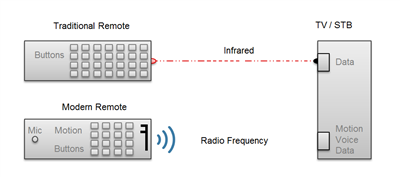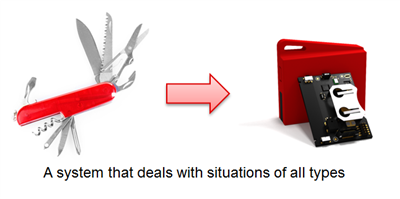SSZTC64 September 2015 CC2650
Have you ever seen a Swiss Army Knife? It’s that small little innocent pocket sized piece of hardware which is loaded with innovative tooling solutions in a truly compact package, and not only a knife which the name would suggest. I love the fact that the little tool brings a solution for so many things; a true multi-tool. It’s an inspiration for all kinds of innovations, gadgets, and now development kits. It’s multi-purpose, simple to use and targets everyone.
The wireless technology equivalent to the Swiss army knife would be something with the same properties. Small, simple to handle and provides solutions for more challenges than a developer can even think of. With a low cost and ease to use concept to rule all aspects of the wireless IoT buzz words; would not that be the undisputed master development kit that would take the market by storm?
Allow me to elaborate briefly on two seemingly pseudo-random wireless communication markets where this wireless equivalent to a Swiss Army Knife simply fits in as anywhere else.
Why Bluetooth Low Energy Re-invents the Modern Remote
Remember the old days when you had to point the remote towards the TV; or later 80s when you could point it in the opposite direction and still make it work? Those remotes used IR (non-visible light) to transmit information over the air. Since the communication is based on light, it means that line of sight is required or with strong enough signal, the communication could “bounce” on or be reflected by objects. With most modern TVs and Set Top Box (STB) solutions, you will find that this line of sight is no longer required; you will be able to hide the receivers behind closed cabinets or use the remote from another room. It’s because these modern solutions uses Radio Frequency (RF) technology.

The information now travels through and around objects. In wireless connectivity systems, there are several protocols that can be used to achieve low power operation and for remote, STB and TV markets; a standardized protocol is required. ZigBee® RF4CE™ is dominating the STB market, while Bluetooth classic has been popular in the TV market. Bluetooth low energy is marching in with big steps to taking over the TV market due to lower cost and power than Bluetooth classic, and entering the STB market where a Bluetooth low energy 4.0 host is included. The benefit of using Bluetooth low energy is that most modern TVs already have a Bluetooth low energy solution which means that any Bluetooth low energy remote (or modern smart phone for that matter), could be used to change the channel.
However, changing channels is not the only common interaction nowadays. TVs and STB are being packed with apps, games and functionality that require faster and more precise input data. Some vendors already have remotes with air mouse capabilities and voice transmission. With Bluetooth low energy, the implementation is trivial with already standardized profiles (such as Human interface Devices – HID over GATT) and with the help of a decent development kit with on board 9-axis motion tracking and digital microphone, the prototype solution is already there. What if you could buy a full featured development kit for $29, to evaluate the proposed application? Do you see where I’m going with this?
The future for interactive communication lies in smart and innovative solutions. Gestures and voice commands allow new interactive ways of interfacing information or entertainment source.
Why Bluetooth Low Energy Brings “Smart” to Automotive
Being on the topic of remotes, have you considered how many point-to-point communication lines exist in a car? Side mirrors, seat heaters, tire pressure not to mention the key fob to enter and start the car. The examples are many, and wireless communication using Bluetooth low energy can be used for all of them. Let’s focus on the most obvious, the key fob. How can Bluetooth low energy be beneficial other than allowing a smart phone to open the car?
A Bluetooth low energy key fob would be advertising and based on the transmitted information is recognized by the car. The car could then request an encrypted and authenticated connection to verify the key. When that is done, let’s say 30ms later, the car would open the door. It’s simple, although imagine the various ways that might trigger the advertising in the first place. It could be button press, but that’s old school and boring. How about voice command? Little bit too much Knight Rider maybe. Then I would suggest motion. Motion could be a unique movement or anything except “no motion” (lying still on table) or constant (walking). One example could be swiping to the side, or double tapping toward the leg. Ergonomics has a lot of say here; obviously it’s all about allowing a small but significant and distinct movement. Or, if you are a Harry Potter fan, there are plenty of wand movements to mimic. As you can imagine, there is plenty of room for innovation here.

Back to the Swiss army knife, what did that have to do with what was just discussed? Well, the truth is that the new SimpleLink SensorTag from TI is packed with all necessary functionality to implement the above scenarios. It’s the wireless equivalent of the Swiss Army Knife. The onboard sensors (motion/temperature/magnet/light/pressure etc.) and a digital microphone are just the start of a new way of creating smart applications. There are also development plug-in modules that allows any additional sensor (ex. Grove Sensors) or interactive components to be interfaced for a complete solution prototype. With a full software development kit and all required tools, rapid prototyping is not only simple; it’s fun as well. To accelerate the development, there are iOS and Android apps available for rapid prototyping.
The new SensorTag uses the SimpleLink CC2650 ultra-low power wireless microcontroller with a 2.4GHz software configurable radio. Oh, and did I mention that the new SensorTag supports more than Bluetooth low energy? It also supports ZigBee, 6LowPAN, RF4CE or almost any other 2.4GHz proprietary protocol. So don’t be shy if Bluetooth low energy is not your fetish.